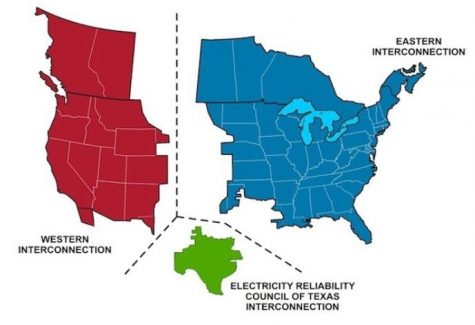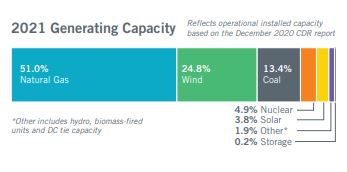A Chilling Time in Texas

May 21, 2021
From around February 11th to the 24th of this year, Winter Storm Uri crossed North America and caused a mass power outage for Texas as more than four million people lost power.
While the storm may have hit several states and countries, the reason Texas particularly struggled to deal with it was due to the setup of the United States’ electrical grid. The power grid for 48 of the states is split into three sections: the Eastern Interconnection, the  Western Interconnection, and Texas. In other states, the power grid is shared across the states in its section. This means that if one state has a blackout it can be quickly resupplied with energy provided by the rest of the interconnection that is still functioning properly. However, rather than being connected to other states, Texas’ electricity is mainly run by a nonprofit, ERCOT (Electric Reliability Council of Texas), and is isolated from other power grids. In the event of a mass power outage, like the one that occurred due to the storm, Texas has a difficult time regaining power due to not being supported by an outside source.
Western Interconnection, and Texas. In other states, the power grid is shared across the states in its section. This means that if one state has a blackout it can be quickly resupplied with energy provided by the rest of the interconnection that is still functioning properly. However, rather than being connected to other states, Texas’ electricity is mainly run by a nonprofit, ERCOT (Electric Reliability Council of Texas), and is isolated from other power grids. In the event of a mass power outage, like the one that occurred due to the storm, Texas has a difficult time regaining power due to not being supported by an outside source.
The state lost power for two reasons: the demand for energy and low temperatures. As temperatures fell and Texans turned on their heaters the energy system could not meet their demands and was unable to recover due to the cold. In addition to freezing natural gas wells, the state’s main source of
energy, the weather also froze wind turbines and coal piles, and blocked pipes. Texas had been warned by the  Federal Energy Regulatory Commission and the North American Electric Reliability Corporation that its electrical equipment would not be sufficient in severe cold weather after the Groundhog Day Blizzard of 2011. However, much of the equipment has yet to be winterized. To ration out the energy, ERCOT chose to roll minor power outages while trying to find a solution and avoid a much larger power outage that could have lasted for several months.
Federal Energy Regulatory Commission and the North American Electric Reliability Corporation that its electrical equipment would not be sufficient in severe cold weather after the Groundhog Day Blizzard of 2011. However, much of the equipment has yet to be winterized. To ration out the energy, ERCOT chose to roll minor power outages while trying to find a solution and avoid a much larger power outage that could have lasted for several months.
The people of Texas were asked to conserve energy. ERCOT recommended that they should turn down their thermostats to 68 degrees and close their shades and blinds in order to insulate the windows, reducing the amount of heat lost. Unplug or turn off non-essential lights and devices while avoiding the use of large appliances such as ovens and washing machines. Businesses and large consumers of energy were also recommended to shut down or reduce electricity-dependent equipment as much as possible.
The storm has also resulted in other incidents as well. Reportedly, 111 people have died from the storm. Those who died include a woman and an eight-year-old girl who was found dead due to carbon monoxide poisoning as the woman was running a car in the garage to keep warm while the girl was in a condo connected to the garage, additionally, a man and seven-year-old boy were brought to the hospital for carbon monoxide poisoning. Furthermore, an eleven-year-old boy also died from hypothermia in his family’s mobile home despite being layered in clothes. Due to attempts to keep warm without electricity, people decided to find heat by starting fires with household appliances and other everyday objects, resulting in a sharp increase in work for firefighters. Many Texans were also unused to icy road conditions, leading to numerous fatal car pileups.
However, one of the more drastic products of the storm was the water failure that occurred shortly after the power went offline. The loss of electricity caused water treatment plants to go offline and the cold temperatures ended breaking water mains across Texas. The people had no choice but to run their faucets to prevent their pipes from freezing. The combination of the shutting down of treatment plants and the demand for water due to people running their pipes resulted in a sharp decrease of pressure in the water system. The loss of pressure caused the bacteria that would have normally been killed off by the treatment plants and pressure to remain in the water that was being sent to the people. Much of Texas was told to boil their water in order to make it safer. However, many still had no electricity or way of starting a fire to boil their water. People and hospitals were forced to collect rain for clean water. For those who did not run their pipes or whose pipes were unsuitable for freezing weather, their pipes eventually burst causing flooding in houses in addition to the other problems during the storm. To escape the storm many fled to the houses of friends and family as well hotels in hopes that their conditions would be better.
Many blamed the state’s Republican leadership for not being able to properly warn local leaders and the people of the storm and precautions that should have been taken. The leadership was also criticized when Texas Governor, Greg Abbott, claimed wind turbines were at fault for the loss of power in an interview with Fox News and when Senator Ted Cruz left for a vacation amidst the crisis. However, quickly returning from his trip, Senator Ted Cruz came back to help pass out water to those that were struggling with the water crisis, and the Harris County Republican Party provided various opportunities to help to support those who needed help during this time.











